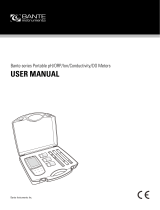
1
I. INTRODUCTION
Thank you for selecting the feature-packed Ultrameter II™, one of the
Myron L Company’s latest in an increasing line of instruments utilizing
advanced microprocessor-based circuitry and SMT manufacturing
processes. This circuitry makes the instrument extremely accurate,
reliable and very easy to use.
The Ultrameter II incorporates several new features including a clock
with time and date, an increased memory of up to 100 locations with
time and date stamp, the ability of the user to adjust the timeout “Auto
OFF”, and enhanced performance. See Features and Specications on
pages 2 & 3.
The most exciting new feature is data logging with the ability to download
the memory or stored test data with its corresponding time and date.
This feature allows the user to create spreadsheets and graphs with
ease, and quickly and accurately manipulate data more effectively. The
optional uDock™ and software is compatible with most computers using
either Microsoft Windows XP or 2000™, or Macintosh OS9.2 or OSX™.
The data may be imported into a variety of spreadsheet formats like
Microsoft Excel CSV™.
Please Note: Although the Myron L Company has performed extensive
testing, we can not guarantee compatibility of all applications and
formats. We suggest testing your application and format for compatibility
before relying on it.
For your convenience, on the bottom side of your Ultrameter II is a
brief set of instructions. A waterproof pocket sized card with abbreviated
instructions is also included with the instrument.
Special note ...... Conductivity, resistivity, and TDS require mathematical
correction to 25°C values (ref. Temperature Compensation, pg. 37). On
the left of the Ultrameter II’s liquid crystal display is shown an indicator of
the salt solution characteristic used to model temperature compensation
of conductivity and its TDS conversion. The indicator may be KCl,
NaCl, 442™ or USER. Selection affects the temperature correction of
conductivity, and the calculation of TDS from compensated conductivity
(ref. Conductivity Conversion to Total Dissolved Solids (TDS), pg. 40).
The selection can affect the reported conductivity of hot or cold solutions,
and will change the reported TDS of a solution. Generally, using KCl for
conductivity, NaCl for resistivity, and 442 (Natural Water characteristic)
for TDS will reect present industry practice for standardization. This is
how your instrument, as shipped from the factory, is set to operate. For
use in sea water desalination for example, both the conductivity and
TDS may easily be changed to NaCl.
























